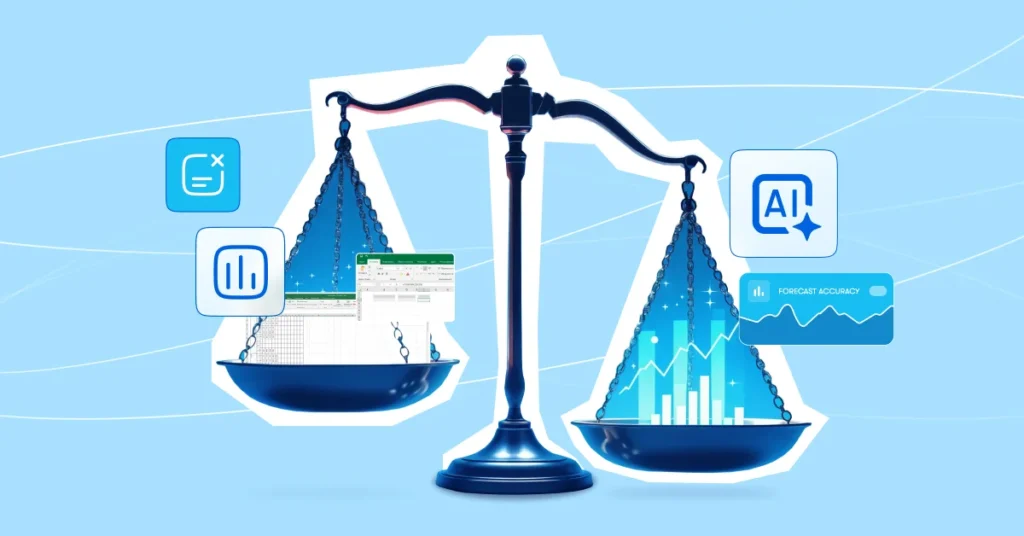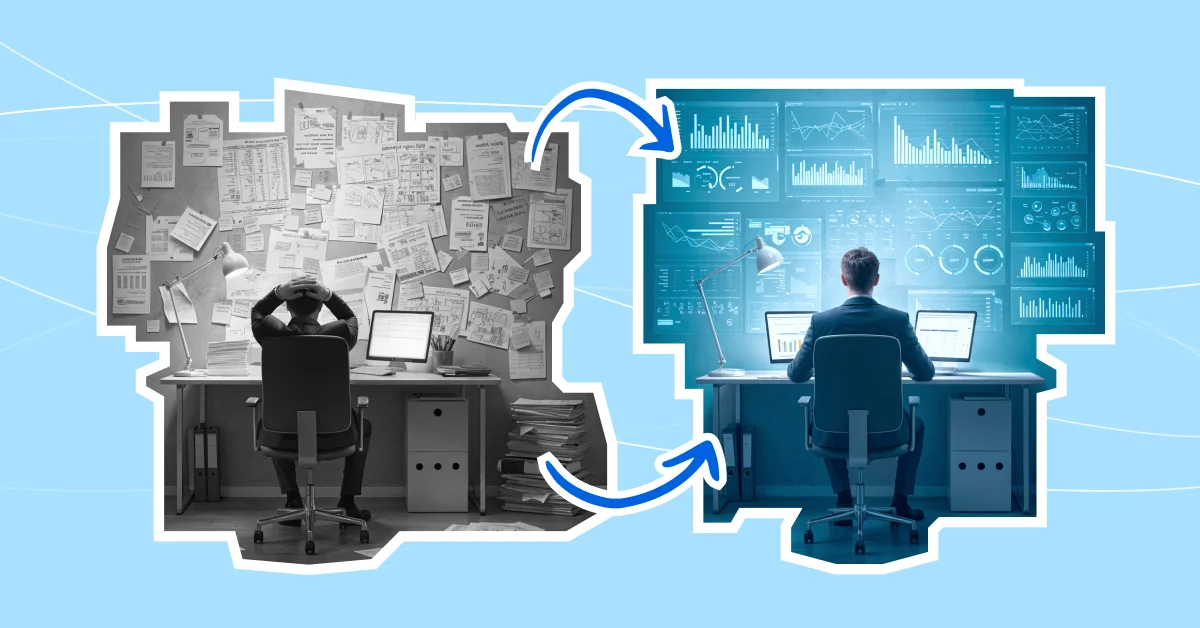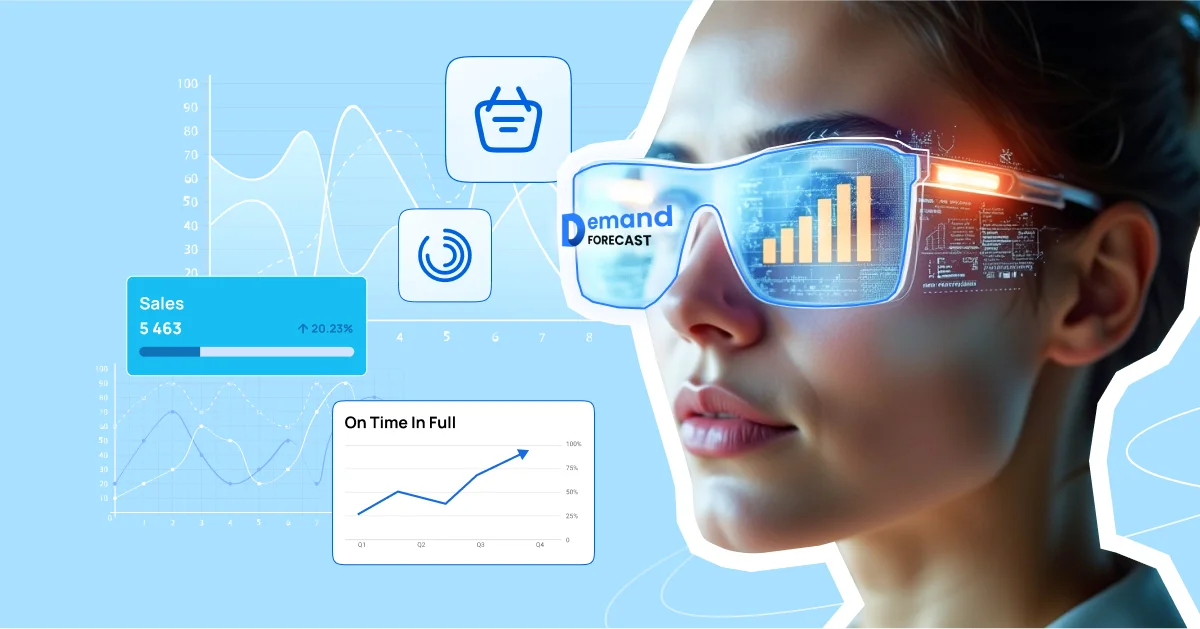13 Jun 2025 11 MIN READ
AI Technologies in Demand Forecasting: From Traditional Methods to Modern Solutions

AI is not a threat; it’s an opportunity for businesses to redefine what they do
Just a few years ago, most companies forecasted demand primarily using manually created spreadsheets, intuition, and the predictions of managers familiar with the market. But in today’s turbulent economy, with ever-changing customer preferences and a flood of data, the old approaches are becoming less and less effective. In the modern world, demand forecasting is not only about applying experience – it also involves working with large volumes of data (often inconsistent) and configuring precise algorithms.
This is where artificial intelligence comes into play. It’s important to note that AI does not replace analysts – it empowers them. With AI tools, companies are no longer guessing the future – they are modeling it based on thousands of real-time variables. Practice shows that demand forecasting using modern solutions enables companies to stay ahead of the curve – even before competitors relying on traditional approaches manage to notice shifts in market trends. For example, according to McKinsey statistics, companies that have adopted artificial intelligence report an average 10–20% increase in forecasting accuracy.
So how exactly is artificial intelligence transforming these processes? Let’s take a closer look.
Why Time-Tested Demand Forecasting Methods No Longer Work
Before artificial intelligence entered the market, businesses had relied for decades on traditional demand forecasting methods. These models combined mathematical calculations with employee expertise – and they proved effective in stable market conditions. The most common methods, still in use today, include:
- Regression models — a statistical tool that helps predict future demand based on relationships between variables. Simply put, the model analyzes how changes in certain factors (such as price, seasonality, advertising, or consumer income levels) affect others – particularly the demand for a product or service. This method provides a quantitative estimate and allows for the consideration of multiple factors at once but struggles with sudden data changes.
- Trend analysis — a method based on identifying long-term changes in data. It helps uncover the overall direction: whether demand for a product is rising, falling, or remaining stable over time. This analysis is useful for strategic planning and is often applied in predictable environments. However, trend models don’t account for seasonal fluctuations or short-term spikes, potentially offering an oversimplified view of reality.
- Expert judgement — a forecasting method based on professional assumptions, experience, and intuition. It involves insights from sales managers, marketers, or external analysts who understand the market’s specifics. This method is quick and accessible, especially for small businesses, but its main drawback is subjectivity: forecasts can be biased or based on incomplete information.
- Moving average — a simple statistical method used to smooth out data fluctuations. It calculates the average of previous periods to identify a baseline trend. For example, a three-month moving average considers the past three months to calculate each new point. The method is effective under stable conditions but insensitive to rapid changes.
- Exponential smoothing — an enhanced version of the previous method, where more weight is given to recent data. As a result, the model responds more quickly to changes in demand. It’s used for short-term forecasting, particularly when fast response to fluctuations is required. However, this model also doesn’t take causal relationships into account and may be unreliable during sharp market shifts.
- Seasonal forecasting — a method that factors in recurring demand fluctuations during specific times of the year (holidays, seasons, events, etc.). It helps isolate and neutralize the seasonal component to more accurately assess the overall trend. This approach is useful in retail, tourism, and the FMCG (fast-moving consumer goods) sector. However, seasonal forecasting doesn’t work outside of established cycles and doesn’t account for unpredictable changes.
Although these models remain part of the demand forecasting toolkit, they have a number of limitations. The most common ones are subjectivity – especially in expert assessments (the human factor can distort logic due to bias or limited information) – and scalability issues (it’s often difficult to adapt classical models when the number of influencing factors grows exponentially). In addition, traditional methods often cannot process large volumes of unstructured data (such as customer behavior in a mobile app or the impact of weather on sales). They also respond poorly to abrupt market shifts, as they rely on the assumption of relative stability.
So even the most accurate formulas of the past become ineffective when the business environment changes at such a rapid pace. And this is exactly where AI offers its main advantage – adaptability.
What Has Changed with the Emergence of AI: Obvious and Hidden Advantages of Artificial Intelligence in Demand Forecasting

In the past, forecasting for several hundred SKUs could take weeks, whereas today AI models such as SMART Demand Forecast can generate forecasts for thousands of items in just minutes. This frees up analysts’ time for strategic work and enables decision-makers to make well-informed decisions quickly.
AI can simultaneously process thousands of variables, detecting correlations that would remain invisible even to an experienced analyst. And it’s not only about internal business data – AI also takes into account external information such as:
- Macroeconomic indicators: inflation rates, currency fluctuations, market trends.
- Climatic and seasonal factors: weather changes, natural events, etc.
- E-commerce data: user behavior, impact of advertising (including on social media).
- Regulatory changes: new taxes, regulatory restrictions, and more.
These factors are integrated into demand modeling algorithms and enable forecasts that adapt to market changes in real time. As a result, AI not only analyzes the past – it models the future. Some AI-powered solutions, such as SMART Demand Forecast, apply scenario forecasting for promo sales – this allows businesses to calculate how demand would shift under various conditions (such as price changes, discounts, cannibalization effects, or seasonal coefficients). Unlike traditional methods, which provide a single forecast, scenario modeling gives businesses multiple projections at once – from optimistic to pessimistic.
This approach enables businesses not only to react but to act proactively: optimize inventory, adjust pricing, launch promotional campaigns, or adapt supply chains. In other words, a company’s position in demand forecasting shifts from reactive to proactive.
This advantage becomes especially critical in times of unexpected global crises – such as pandemics, sudden shifts in consumer behavior, geopolitical upheavals, and so on. In such cases, the speed of decision-making and the ability to anticipate demand fluctuations determine not just competitive advantage but the very survival of a business.
Comparing Traditional Forecasting and AI Across Specific Criteria
Let’s take a closer look at the differences between traditional demand forecasting models and SMART Demand Forecast — an AI-powered solution:
| Criterion | Traditional Methods | AI-Based Method |
|---|---|---|
| Data Processing Speed | Limited: depends on human resources and manually controlled software | High: automatic processing of large volumes of data in real time |
| Forecast Accuracy | Moderate: high error rate in volatile environments | High: takes many variables into account and uses self-learning models |
| Level of Automation | Low: most steps are done manually, resulting in a lot of time being spent on routine tasks | High: automated data collection, analysis, and forecast updates |
| Flexibility | Limited: methods are difficult and slow to adapt to new conditions | High: fast scaling and adaptation to new data and market changes |
| Volume of Available Variables | Insufficient: usually limited to a few key indicators | High: hundreds of parameters are considered and analyzed simultaneously |
| Risk of Subjectivity | ВHigh: dependent on expert opinions or specific employees | Minimal: decisions are based solely on algorithms and data |
| Error Response Speed | Low: recalculating forecasts manually is difficult and time-consuming, leading to shortages and overspending | High: continuous adjustments reduce the risk of critical errors, and recalculations are significantly faster |
| Scalability | Low: models are hard to scale and require high costs | High: a single algorithm can be applied to multiple segments or markets |
Seamless Transformation – When and How to Integrate AI Forecasting Without Risking Your Business

According to McKinsey, between 2023 and 2024, the use of artificial intelligence in business processes increased by 50%. Currently, 7 out of 10 companies are already using AI in their day-to-day operations – and this figure is clearly set to rise. Organizations that have already implemented AI in their forecasting processes not only model demand more accurately, but also make decisions faster, manage inventory more efficiently, and adapt to changes in real time. That’s why the answer to the question “When should a company implement AI in its processes?” is “Now.” In today’s fast-paced market – where trends change weekly and customer expectations shift daily – hesitation can result in the loss of competitive edge.
At the same time, it’s essential to approach this process with care. Halting core business operations during the implementation of new technologies is a risk most companies can’t afford. Temporary loss of control over logistics, inventory, or distribution channels may lead to disruptions in the supply chain, out-of-stock products, customer churn, and financial losses. So how do you avoid that?
How to Successfully Implement AI in Demand Forecasting – Tips and Best Practices:
- Choose a Reliable Vendor: Vendors usually provide full technical support, adaptation to specific business processes, and guidance at every stage of integration – as SMART business does when implementing the SMART Demand Forecast
- Ensure Data Quality: Without high-quality, structured historical data, AI cannot function effectively. The first step is auditing your data sources, types, and quality. Ensure regular updates, standardization, unified formats, and the elimination of duplicates. If you’re unsure how to do this best – consult your vendor. For example, SMART business agrees on a unified data structure with the client as early as the diagnostic stage and provides ready-to-use templates.
- Prepare Your Technical Infrastructure: This may involve an internal computing base or connection to cloud platforms that provide scalability and speed. Make sure your technical capabilities align with the requirements of your chosen solution – your vendor can also help with this.
- Launch a Pilot Project: Start by rolling out the system in one region, SKU, or distribution channel. This allows you to test the solution with minimal risk and evaluate its business value, helping you decide whether to scale the innovation across your entire company.
- Build a Cross-Functional Team: AI forecasting doesn’t just concern IT. Depending on your industry, logistics, marketing, and operations teams may be involved. Bring together employees who will be directly engaged in the forecasting process.
- Train the Team: Explain how the new system works and train employees to use it. Encourage feedback during integration and be responsive to it.
- Involve Analysts: Their role goes beyond interpreting results – they also ensure that forecast accuracy KPIs are met. AI is, first and foremost, a tool in human hands, not a replacement. It handles the routine and frees up your team for higher-priority tasks.
- Extra Tip: If you’re unsure about implementing process changes, introduce the solution gradually. Initially run AI models in parallel with your existing methods in test mode, and compare the results.
A study by Boston Consulting Group showed that AI-based forecasting can lead to a 5–10% revenue increase by improving product availability, optimizing pricing, and reducing losses from missed sales. At the same time, inventory costs may drop by up to 25% due to better stock level optimization. So it’s safe to say that a well-managed transition to AI forecasting is an investment that starts paying off almost immediately.
If you want to implement artificial intelligence in demand forecasting with guaranteed technical support – submit a request, and SMART business experts will help you select and integrate a solution tailored to your specific processes.
